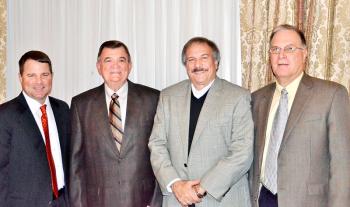

Driller: Deep is the future oil & gas drilling
The future of onshore oil and gas drilling in south Louisiana will rely heavily on wells being drilled 20,000 feet or deeper, and will utilize deepwater drilling technology in order to drill through salt domes to get to oil and gas, James Orth, president, director, and co-founder of ORX Exploration, said Tuesday.
Orth, whose company is headquartered in New Orleans, was the guest speaker at Tuesday’s Atchafalaya Chapter of the American Petroleum Institute meeting at the Petroleum Club of Morgan City.
Exploration in south Louisiana is changing “quite a bit” and has changed a lot over the past 10 to 15 years, Orth said. Today’s imaging technology has the capability to capture images of oil and gas deposits around salt domes and is driving what Orth thinks will be a boom in drilling in south Louisiana over the next decade, he said.
“We have to apply leading edge technology in and around existing salt domes if we’re going to have a play that’s going to continue here in south Louisiana,” Orth said. “We also have to have improvements in our drilling and operational performance to drill to these depths.”
Companies, such as, Exxon, BP and Shell, are out in front with new drilling technology mainly because of deepwater drilling. “As that technology’s becoming available, it’s helping us to apply it here in south Louisiana,” Orth said.
Since the inception of the oil and gas industry in south Louisiana, about 90,000 oil and gas wells have been drilled. Of those wells, 7,375 wells have been drilled to depths greater than 15,000 feet; 1,500 wells have been drilled to depths of 18,000 feet or deeper; and 392 wells have been drilled deeper than 20,000 feet, Orth said.
“If we’re going to have a new rebirth or a new frontier across south Louisiana, it is going to have to come at depths greater than 15,000 feet,” Orth said. However, those wells are extremely expensive to drill so companies will start drilling fewer wells while going to greater depths, he said.
For anyone looking to drill deep wells in south Louisiana, salt domes will be a major factor in that effort, Orth said. The deepwater technology being used to go through salt layers is going to allow drillers on land to “develop some of these deep plays in south Louisiana,” Orth said.
“In the old days, the conventional wisdom was that there’s a big salt layer underneath the Gulf of Mexico, Louisiana called the Louann Salt and at depths of 30,000-40,000 feet,” Orth said. “The conventional thought for a hundred years was that all of these salt pinnacles or salt domes in south Louisiana came up from this Louann Salt. What we’re now finding is that a lot of these domes are detached, separated, leaning, come in all shapes and sizes.”
Underneath a lot of the salt are structures containing oil and gas, Orth said. Major oil and gas discoveries in eastern south Louisiana and encouraging possibilities in south central Louisiana are a “pretty good trend south of I-10, but it’s all deep. It’s all 20,000-plus-foot wells,” he said.
The Tuscaloosa Trend, which has seen some major oil and gas findings north of Baton Rouge, has a well contained within that trend being drilled by McMoRan Exploration to about 30,000 feet in the northern part of lower St. Martin Parish. “There are rumors out there that it’s pretty encouraging as far as possibilities in the Tuscaloosa so that’s going to help quite a bit to help accelerate this trend,” Orth said. McMoRan Exploration has invested about $125 million to $150 million in that well, he said.
ORX Exploration plans to drill a roughly $50 million well to slightly more than 20,000 feet in Valentine, which is located in Lafourche Parish, jointly with McMoRan, Orth said.
Orth’s company also is working to drill a well with two other companies at southeast Avery Island. “We’re pretty encouraged because we’ll have two wells here in the mix this year along with what has already been announced.”
- Log in to post comments
